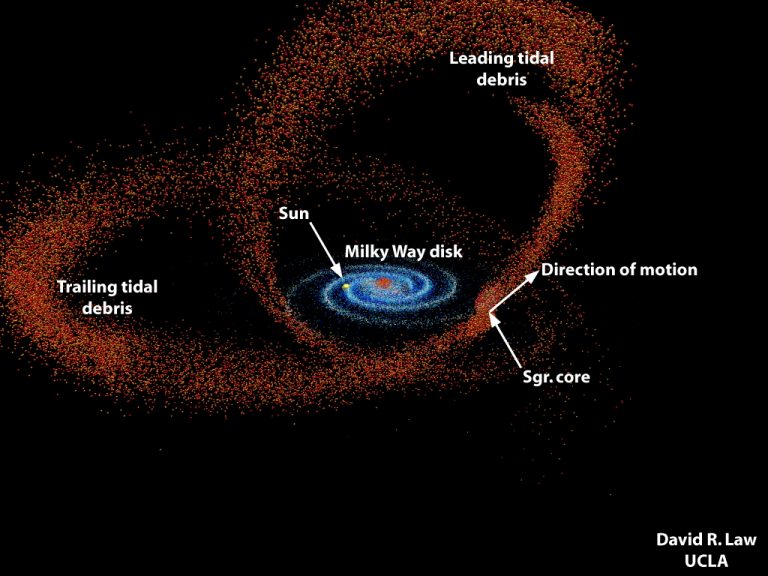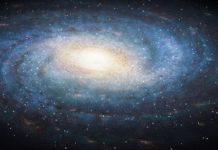Research shows that some Milky Way star clusters did not form within the galaxy, but appear to have been “stolen” from other galaxies
According to recent research in astronomy, most large galaxies arose from the merger of small galaxies. This means that some star clusters currently in the Milky Way may have been inherited from absorbed galaxies, or even “stolen” from neighboring galaxies such as the Magellanic Clouds.
The first connections between these clusters and different host galaxies were discovered in the 1990s, but recent research has become increasingly informative, allowing the percentage of clusters stolen and which clusters were “stolen” to be determined.
The Milky Way is adjacent to a large number of galaxies. This includes the famous Magellanic Clouds, as well as lesser-known ones such as the Fornax Dwarf Galaxy and the Antlia 2 Dwarf Galaxy.
The discovery of streams of ruptured clusters driven by tidal forces has offered a possible explanation for why many star clusters in the Milky Way are similar in age while others are relatively young. Astronomers have suggested that these young clusters formed inside dwarf galaxies.

Over time, more and more evidence has been collected to support this argument. In 2002, the cluster NGC 5634 was discovered to be in a stream emanating from a dwarf galaxy in the constellation Sagittarius. Its motion and poor metal content also pointed to an origin in a dwarf galaxy. Since then, astronomers have found compelling evidence that several other star clusters are associated with this stream-torn galaxy. Among them: AM 4, Arp 2, Pal 12, NGC 2419, NGC 4147, Terzan 7, Terzan 8, Whiting 1. Meanwhile, other streams of broken dwarf galaxies have been discovered, including the Helm Stream, the Gaia-Enceladus Stream, and the Sequoia Galaxy. More associations with additional star clusters followed.
In addition to the galaxies currently undergoing engulfment, astronomers have also suggested that some more intact dwarf galaxies orbiting the Milky Way could have contributed.
how did star clusters from other galaxies end up in the Milky Way?
In a recent series of papers, astronomers from the Iran University of Science and Technology have studied how various neighboring galaxies of the Milky Way can exchange clusters. In their first work, they built models of dwarf galaxies with star clusters in different orbits around the Milky Way to study how easily their clusters could separate from their host galaxy.
They found that the percentage of such clusters varied from 12% to 93%. Clusters were most often “stolen” if they had elliptical orbits that reached the outskirts of their parent galaxies. However, more massive galaxies were better able to hold together their clusters. Based on this range, the paper suggested that at least two clusters could have been stolen from the Fornax galaxy, four from the Large Magellanic Clouds, two from the Small Magellanic Clouds, and fourteen from the Sagittarius dwarf galaxy.
In the second paper, the researchers took a different approach and studied the orbital characteristics of 154 globular star clusters and compared them with the characteristics of 41 dwarf galaxies around the Milky Way and other tidally disrupted systems. They identified 14 clusters associated with the Sagittarius dwarf galaxy. However, their results disagree with other studies regarding exactly what kind of clusters these are. Five clusters previously associated with the Sagittarius dwarf galaxy, according to the authors, did not have sufficiently similar parameters to be considered “stolen.”
However, they identified four new globular clusters not previously associated with the galaxy as having a high probability of originating in another galaxy, and six others with a lower probability. The study also found six clusters that likely formed in the Large Magellanic Cloud. As a result, their review notes that 29 of the known star clusters have properties similar enough to the dwarf galaxies considered to trace their connection.
The authors acknowledge that their models are somewhat oversimplified because they do not fully account for the three-dimensional structure of dwarf galaxies. Thus, they leave it open for future research, which will include further study of the newly identified star clusters.
These studies provide more evidence that the Milky Way’s star clusters are not its population. They are a combination of clusters from other galaxies and clusters formed within satellite galaxies.




